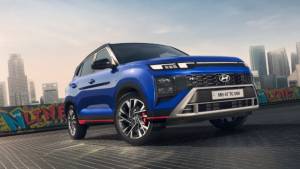French open
Chablis, a small town and commune in Burgundy, is 10 kilometres further north of where I've parked. It is known for just one thing, its wine. Chablis wines are one of the most famous white wines in the world and are made from the Chardonnay grape. These wines are popular for their flinty taste, and are renowned for their distinctly dry, full bodied and very acidic flavors. Unfortunately the most I got to see of Chablis was the signboard pointing the direction in which it lay. No regrets since I am not very keen about whites, red is more my colour. But there I was, driving the Renault Fluence in the Burgundy region which despite the name has more shades of green than red. The Fluence though could make the Germans, Japanese, the Koreans and even the Indians see red, no kidding! The Fluence is Renault's comeback car for India and will be instrumental in rebuilding the brand that never really took off. Learning from its mistakes Renault now aims to step upmarket, introduce India to French flair and pizazz, and take on the likes of the Civic, Corolla Altis and Laura with - and this will be a crucial factor in the car's success - a package that is almost Kizashi-sized. The Fluence is based on the Renault-Nissan C platform, a front-wheel drive architecture that has spawned cars such as the Megane III, Koleos and Scenic for Renault, and the Qashqai and X-Trail for Nissan. The Fluence is also sold as the Samsung SM3 in Korea through Renault Samsung Motors. In fact the development of the Fluence has seen several of Renault's alliances and partners deeply involved in the project, and so far it has been fairly successful. But talking about success, now we all know how the Logan, produced jointly by Renault and Mahindra in India, didn't script the success story expected. It had all the right ingredients - an efficient diesel motor, great space, great comfort - but one thing that wasn't accounted for was that India and Indians had moved forward with the car becoming an extension of one's personality and lifestyle. The Logan bombed, because it lacked the flair and flamboyance that are very essential in this market to attract consumers (and it wasn't as cheap as we all expected). It looked as interesting as the cover of a school textbook, and how much attention does a Wren and Martin get? So in that respect the Fluence is a much more appealing car visually than the Logan could ever hope to be. As an ice-breaker it has all the right elements to pique consumer interests. It has a distinct shoulder line that gives it a strong European character. The hood has two creases on the flanks leading from the windshield and tapering towards the front grille eyelining the large clear lens headlamps that swoop backward to the fenders. However the rear with the wraparound tail lamps and the chunky bumper is the most attractive end of this car. It's well defined, has a lot of character and is quite attractive. You wouldn't call it gorgeous though, the Fluence being penned before Renault rediscovered its futuristic design mojo. Up close you notice that the details are at odds with each other. It has a narrow grille overlooking a wide bumper and air dam, the hood has a slight bulge and the cabin looks disproportionately larger than the engine bay or the boot. That large cabin however means you get a lot of space. The Fluence is a large car both in length and breadth. It's as long and wide as the Suzuki Kizashi so you get generous amounts of leg and shoulder room. And with deep seats at the rear you sink lower into the car so you get enough head room as well. I could in fact take a safe bet and say that the Fluence will offer generously more interior space than any of its competitors. But while the accommodations are well thought out the dashboard is innovative. There are four distinct layers to the dash, each separated from the other by a horizontal crease. Each layer then incorporates a set of comfort or convenience features placed within clearly designated areas one above the other making it look like a stack of boxes. So the top layer has the navigation system, below that sit the aircon vents, further below is the climate control and the last layer has a single-CD audio system. It is a very original theme though not very efficient. The audio control knobs for instance would need a child's fingers to operate them, they are so small and tightly bunched up. There are other quirks such as the navigation system, I'm certain India spec cars will also have a navigation system available from the off, but you get a remote control to operate it not a jog dial like in most cars placed on a dashboard. It's most inconvenient if you need to switch to alternative routes and have to work the system with a remote. So despite the plush leather upholstery, soft touch buttons and the light dashes of aluminium in the cabin, a few minute but nevertheless quirky details shave points off this car's luxury experience. Put those oddities out of your mind though and you realise that this is a fairly comfortable cabin to be in. The seats are plush and supportive and the steering wheel is chunky enough to fit firmly inside your palms. The dials are clear to read though they are canted away from you rather than being more vertical. The glass areas are large providing a clear view on each side and the A-pillar is slim enough not to obstruct vision. Coming to the powertrains there is only one diesel engine available on the Fluence, the familiar K9K platform dCi 1.5-litre common-rail diesel in outputs ranging from 86PS to 106PS of max power. Familiar because one iteration of this engine is being used in the Logan. I drove the 106PS state of tune which is what the Indian cars will have, allied to a diesel particulate filter that allows it to conform to Euro 5 norms and should see it sail peacefully through Bharat Stage 4. Incidentally Renault offers a lifetime guarantee on this diesel particulate filter with several more extremely long lasting service and part replacement schedules for the European markets. As far as petrols go there are two engines on offer globally, 1.6- and 2.0-litre four-cylinder units. We are expecting the 2.0-litre which makes around a 140PS of max power to come to India and that would make it competitive to the Cruze, Laura, Corolla and Civic brigade all of which have petrol engine displacements ranging from 1.8-litres up to 2.0-litres and power outputs from 130PS to a 160PS. Transmission options include a 6-speed manual, a 4-speed CVT which is mated globally to the 2.0-litre petrol and a new 6-speed dual-clutch automatic which Renault claims offers better efficiency and is more eco-friendly than the CVT system. The India specific cars however have not cemented which options will be available at time of launch. The diesel I drove pulls cleanly from standstill though it does not feel hugely powerful. It however is torquey with 240Nm of torque available at just 1750rpm. Power delivery is linear not aggressive and that allows it decent driveability in the city with the capacity to maintain a fairly high pace on the highways. It may not be as energetic as the Laura but it comes close. The engine however isn't as refined as I hoped. Despite the noise insulation the clatter is clearly audible inside the cabin and rises as the revs increase. The manual transmission shift quality is smooth and gears slot in easily, but just how well the ratios are matched to the engine's torque curve will need closer examination. On my drive from Geneva to Paris, a distance of around 530km, at an average speed of around 130kmph, the Fluence consumed nearly a tank and a quarter of diesel. This also included another 100 odd kilometres filming the Fluence around Chablis with a fair amount of trawling through the Swiss-French border so in all I can vouch for the fact that the Fluence offers good efficiency. What the Fluence does best of all though is provide a solid and highly compliant ride quality. The Fluence is built on the Megane III platform and utilises the same subframe which is a stiff and highly robust unit. The front suspension has MacPherson struts with rectangular lower arms and a fairly robust anti-roll bar. The independent rear suspension is adopted from the Nissan Sentra with optimised calibration offering enhanced damping. Where the ride quality came into its own was on the dreaded cobblestoned and rough Parisian roads. You barely feel the high frequency vibes thrown up by the cobbled surfaces and the Fluence's suspension soaks in the roughness admirably. This virtue of the Fluence will perhaps become its strongest selling point in India. The suspension articulation though allows quite a bit of bodyroll. Despite its nearly European standards of stiffness, the suspension travels quite a bit and coupled with the large front overhang (908mm) expect the front lip to scrape across nasty speed-breakers. A little tweaking of ground clearance might be in order for India. The Fluence is composed at motorway speeds though strong gusts of wind or overtaking by large speeding trucks did unsettle her demeanour slightly. You aren't going to be searching for the next corner in the Fluence as it lacks the dynamic capabilities to make for a thrill-a-minute ride. She's confident if pushed hard without excessive understeer, the tyres offer excellent grip but are primarily comfort spec and the steering is capable of making her an engaging car to drive if required. The electrically assisted steering is one of the nicer units I've experienced within urban areas. It's smooth without getting lifeless and has precise coordination with the front wheels. However on the motorways you realise that the weight stays nearly the same throughout, neither too dull nor too light. So settle back and enjoy the luxury and comfort because that's what the Fluence does best. The Fluence is an exceptionally comfortable car to drive, especially over long distances. With the choice of both petrol and diesel engines as well as manual and automatic transmissions, she also offers good value to a wide range of consumers. One concern remains: how does Renault intend to sell the cars and provide after sales service, particularly since Mahindra-Renault showrooms have all gone to the former? To address that situation Renault will have ten of its own dealers up and running by June which is when the Fluence will be launched, increasing to 30 by the year end. By the end of 2012 it claims 70 dealers will be operational to cater to the 5-car range they will have on offer by then. The Fluence will be assembled at the Renault-Nissan Alliance factory near Chennai and to further keep prices competitive production of the K9K engine will be localised which should keep the car in the meat of the entry D-segment, Rs 13-15 lakh. The Fluence then is a good choice of car for Renault to reignite its campaign in India with. It is well balanced with all the right aggregates to appeal to an upper middle class buyer. That is what Renault needs in India, a well packaged no-nonsense car which is efficient, spacious, comfortable and handsome without trying too hard. It is in the truest sense a global car, a car that has been developed in various markets stretching from Europe to Asia and the Pacific, utilising engineers with various sensibilities, cultures and solutions. It's this diversity of engineering that should see it fit in comfortably in the most diverse country on the planet.















